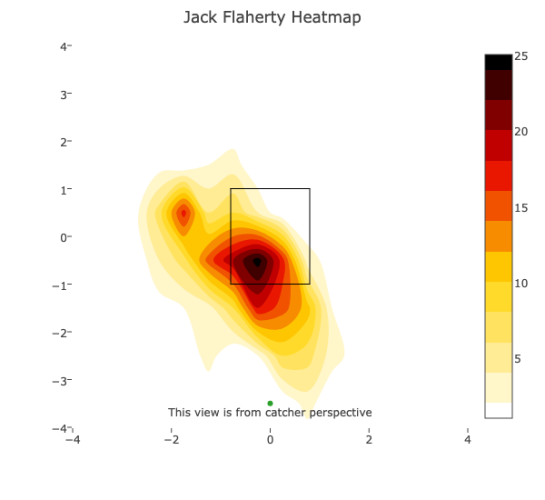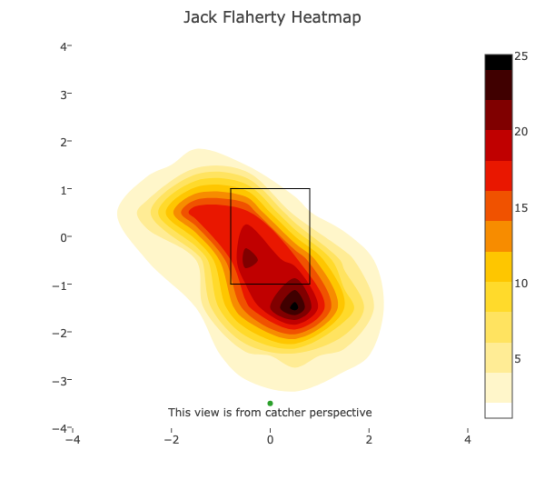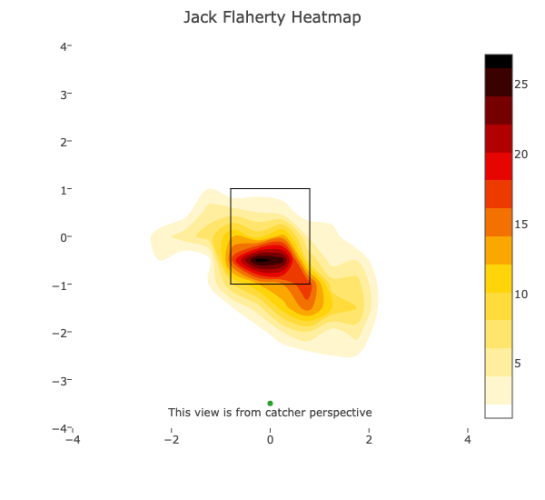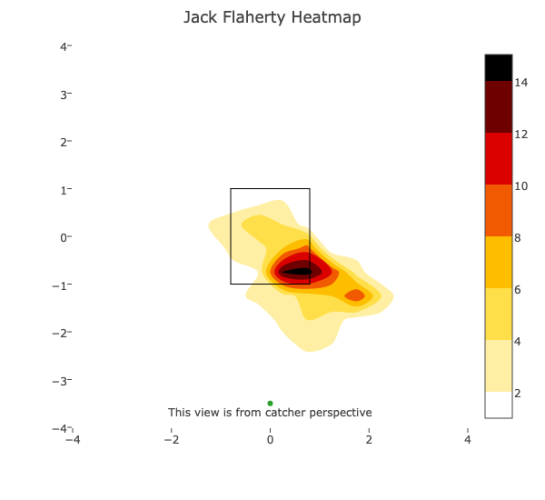Dissecting Jack Flaherty’s Approach Against Lefties
In 2018, Jack Flaherty took significant strides towards looking like a potential front-of-the-rotation starter for the St. Louis Cardinals. He posted a 3.34 ERA across 151 innings, striking out nearly 30% of the batters he faced, while holding a 3.58 xFIP. Additionally, he maintained strong numbers against both righties and lefties. As a result, expectations for Flaherty in 2019 were high. Projection systems called for an ERA between 3.30 and 3.60, which placed Flaherty among the top 15-20 pitchers in baseball, depending on the algorithm. However, through 97 innings in 2019, Flaherty has fallen short of those marks. Going into the All-Star break, the young righty held a 4.64 ERA with a 4.07 xFIP. Peripherally, his strikeout rate (K%) is down 3%, his ground-ball rate (GB%) is down 5%, and his hard-hit% is up as well. Investigating further, one of the biggest differences between Flaherty’s 2018 and 2019 seasons is his performance against left-handed hitters.

While worse than his performance against righties, in Flaherty’s .275 wOBA against left-handed hitters in 2018 ranked eighth out of all right-handed pitchers with more than 300 total lefties faced, and his 26.8% strikeout rate against them ranked twelfth. Those numbers place him around pitchers like Aaron Nola, Jose Berrios, and the 2018 version of Mike Foltynewicz. Those are good pitchers! However, Flaherty’s performance against lefties in 2019 has not held up — take a look at the numbers.

It’s easy to see, but through the first half of the 2019 season, Flaherty has been drastically less productive. His surrounding numbers paint the whole picture: the average exit velocity from lefties has risen from 81.9 mph to 84.4 mph, with their GB% dropping from 42.5% to 35.8%. Lefties have been replacing those ground balls with batted balls in the air, as his FB% went from 34.4% to 41.8%. It doesn’t help either that his HR/FB rate has nearly doubled across the two seasons. The bottom line is that lefties are hitting him harder, and when they do so, their results are better.
One of the main culprits for lefties’ success has been Flaherty’s four-seam fastball. In 2018, the pitch generated an xwOBA of .317 with an average exit velocity of 86 mph. Fast-forward to this year and Flaherty is leaning harder on his four-seamer, increasing its usage from 42.9% to 51.8% to little success. Lefties have increased their average exit velocity to 89 mph, and as a result, the pitch has an xwOBA of .389. Looking at the location of his four-seamer doesn’t yield much insight as Flaherty is still largely targeting the top of the zone. However, lefties have increased their in-zone swing rate by 6% and have had serious success, slugging .605 with an xwOBA of .404. In comparison, lefties slugged .287 with a .303 xwOBA on fastballs in the zone in 2018.
However, Flaherty’s approach with his secondary pitches is a bigger point of interest. In 2018, his knuckle-curve was dynamite against lefties. They slugged just .133 off the pitch with an xwOBA of just .167. Yet in 2019, that has hardly been the case: LHH are slugging at a .526 clip with an xwOBA of .414 against the pitch. This looks related to a serious shift in location of the pitch. In 2018, he targeted the knuckle-curve low-and-away from lefties, which was particularly effective in getting them to roll over into ground-outs. In 2019, however, Flaherty has thrown the pitch far more over the middle of the plate as well as low-and-in on lefty hitters. This change in location leaves far less room for error, as mistakes will more than likely end up in the middle of the zone or below the zone. The numbers back this up as LHH have dropped their chase rate from 27.6% to 13.1% and their whiff percentage from 48.7% to 29.5%.


Among Flaherty’s pitch mix, and what could be the key to getting back on track versus lefties, is his slider. In 2018, the pitch was effective at inducing lefties into ill-advised swings, and that ability has improved into 2019. Against lefties, Flaherty’s chase rate on the pitch has grown from 33.3% to 46.5%, and when LHH do chase, they’re swinging and missing almost 10% more than in 2018. As a result, the K% on his slider has jumped from 43.6% to 48.6%. But this is where things get even more interesting: Flaherty’s slider location has taken a significant change between 2018 and 2019 too. Like the knuckle-curve, Flaherty’s slider has been far more heavily located low-and-in on LHH than in 2018.


Unlike the knuckle-curve, however, the slider has not been knocked around by lefties in the same way. Flaherty’s xwOBA on the pitch has risen from .247 to .278 and the slugging percentage is up from .359 to .429, but he’s cut down his BB% with the slider from 14.9% to 5.4%. Looking at Flaherty’s ability to generate whiffs, as well as getting hitters to chase the slider out of the zone, one would expect him to rely on the pitch more heavily in 2019. However, this has been far from the case. In fact, Flaherty’s decreased the frequency of his slider against lefties in 2019, dropping from 23.7% to 17.9%. In the meantime, his knuckle-curve has risen 3.5% in frequency and his four-seamer has risen almost 9%.
I don’t claim to be a pitching doctor or guru, but moving forward it looks like Flaherty’s path towards improved performance against lefties should come through some slight adjustments to his breaking pitches. Trying to bury his curveball inside on lefties does not seem to be working and has too much associated risk involved when it comes to missing in the zone. However, the slider has been quite dangerous when thrown inside to lefties, and I wonder if trying to throw both breaking pitches in that same general area has had some sort of negative effect for Flaherty. My recommendation would be for Flaherty to return to throwing the knuckle-curve low-and-away from lefties, but to also continue using the slider low-and-inside.
The article originally appeared here on July 11.
This is amazing
Great analysis!